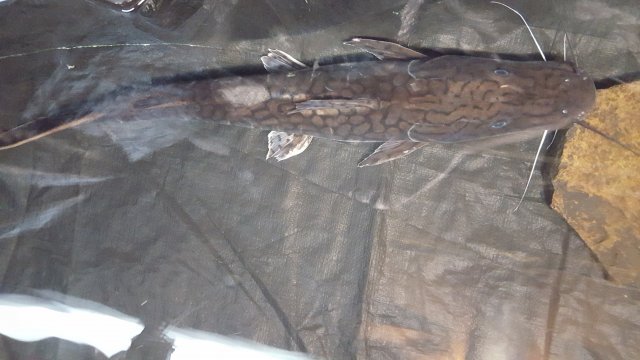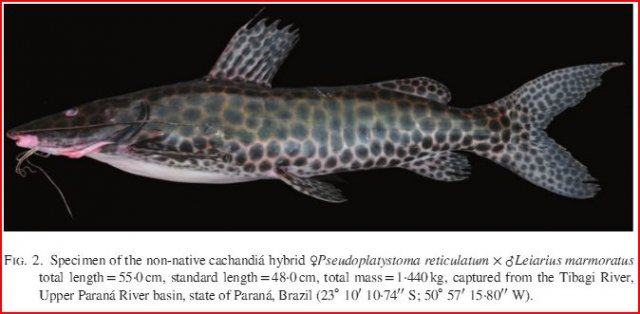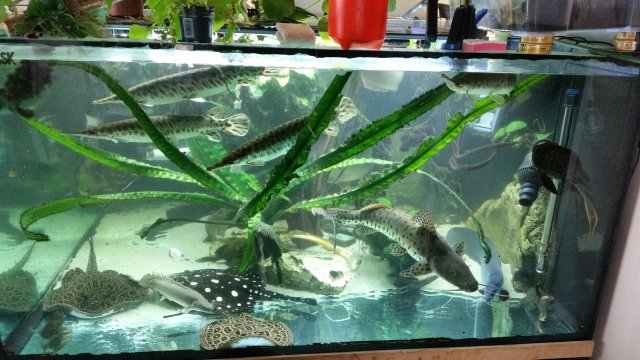TSNxLei, I think. Could it be P. corruscans?
- Thread starter thebiggerthebetter
- Start date
You are using an out of date browser. It may not display this or other websites correctly.
You should upgrade or use an alternative browser.
You should upgrade or use an alternative browser.
Useful and interesting info that goes to show what
 wednesday13
has been telling us a while - we may get hybrids where we think we get genuine species... and more:
wednesday13
has been telling us a while - we may get hybrids where we think we get genuine species... and more:
http://www.scielo.br/pdf/ni/v14n2/1982-0224-ni-14-02-e150139.pdf
Monitoring of the interspecific hybrid production and trade is essential for the appropriate management of these animals in fish farms. The identification of catfish hybrids by morphological analysis is unreliable, particularly of juveniles and post-F1 individuals. Therefore, in the present study, we used five molecular markers (four nuclear genes and one mitochondrial gene) to detect hybrids in the trade of pimelodid juvenile fish from different stocks purchased of five seed producers in Brazil. Samples commercialized as pintado (pure species Pseudoplatystoma corruscans) from three fish farms were genetically identified as hybrid cachapinta (♀ P. reticulatum x ♂ P. corruscans). In the stocks purchased as cachandiá (hybrid between ♀ P. reticulatum x ♂ Leiarius marmoratus) and cachapira (hybrid between ♀ P. reticulatum x ♂ Phractocephalus hemioliopterus), we suggested the occurrence of intergenus crosses involving the hybrid cachapinta, which was used instead of the pure species P. reticulatum. The problems involving the hybrid cachapinta production were discussed in the present study, especially because these animals have caused genetic contamination and threatened the genetic integrity of natural and cultivated populations. In order to improve the surveillance of the production and provide criteria for the correct management of catfish hybrids, genetic markers has become an excellent alternative to the morphological identification, including juveniles or post-F1 generations.
http://www.scielo.br/pdf/ni/v14n2/1982-0224-ni-14-02-e150139.pdf
Monitoring of the interspecific hybrid production and trade is essential for the appropriate management of these animals in fish farms. The identification of catfish hybrids by morphological analysis is unreliable, particularly of juveniles and post-F1 individuals. Therefore, in the present study, we used five molecular markers (four nuclear genes and one mitochondrial gene) to detect hybrids in the trade of pimelodid juvenile fish from different stocks purchased of five seed producers in Brazil. Samples commercialized as pintado (pure species Pseudoplatystoma corruscans) from three fish farms were genetically identified as hybrid cachapinta (♀ P. reticulatum x ♂ P. corruscans). In the stocks purchased as cachandiá (hybrid between ♀ P. reticulatum x ♂ Leiarius marmoratus) and cachapira (hybrid between ♀ P. reticulatum x ♂ Phractocephalus hemioliopterus), we suggested the occurrence of intergenus crosses involving the hybrid cachapinta, which was used instead of the pure species P. reticulatum. The problems involving the hybrid cachapinta production were discussed in the present study, especially because these animals have caused genetic contamination and threatened the genetic integrity of natural and cultivated populations. In order to improve the surveillance of the production and provide criteria for the correct management of catfish hybrids, genetic markers has become an excellent alternative to the morphological identification, including juveniles or post-F1 generations.
Very interesting... great find
 thebiggerthebetter
! Nice to know im not out in left field by myself haha... My only info to go on was from researching food production type places. Came to find out most of them exist on or in the actual rivers themselves in net style "cribs"/tanks so the chance for escapees is great, let alone the "man made" aspect of the gene process. A bit disheartening to know true tsn specimen are almost non existent any more. On the other side its good they are being farmed for food/industry vs. only wild collected. Im glad i saved the rarest of my bunch
thebiggerthebetter
! Nice to know im not out in left field by myself haha... My only info to go on was from researching food production type places. Came to find out most of them exist on or in the actual rivers themselves in net style "cribs"/tanks so the chance for escapees is great, let alone the "man made" aspect of the gene process. A bit disheartening to know true tsn specimen are almost non existent any more. On the other side its good they are being farmed for food/industry vs. only wild collected. Im glad i saved the rarest of my bunch  ...
...

Probably a "dink" from food production... my "suspected" p. tigrinum.

Probably a "dink" from food production... my "suspected" p. tigrinum.
Is this a thought-through or an emotional statement?... A bit disheartening to know true tsn specimen are almost non existent any more...
I mean we realize that hybridization is more widespread than we thought but I, for one, have no clue still of its magnitude.
What is the portion of hybrids in the ornamental TSN trade? 50%? 75%? 90%? 99%?
What portion of TSN labeled as w/c is indeed w/c? 25%? 50%? 75%?
What portion of true w/c TSN might be hybrids? 10%? 25%?
Is this a thought-through or an emotional statement?
I mean we realize that hybridization is more widespread than we thought but I, for one, have no clue still of its magnitude.
What is the portion of hybrids in the ornamental TSN trade? 50%? 75%? 90%? 99%?
What portion of TSN labeled as w/c is indeed w/c? 25%? 50%? 75%?
What portion of true w/c TSN might be hybrids? 10%? 25%?
You propose some good "food for thought" questions. Id say as the yrs go on, well see more man made hybrids and less wc specimen. Most w/c's or claimed to be wc end up bein faciatum...or farm raised hybrids now that we know for sure thats a viable option. If you look at older members specimen 2005 and previous yrs youll notice alot more variety in colors/patterns and id suspect thats because they were still being wild caught back when. Not a bad thing to supply the pet industry with "food grade" hybrid tsn... but where does that leave us who know better lol... ive had dozens of farmies over the yrs... guess we'll just have to wait for Wes to collect some real w/c ones for us again. Im sure theres still a possibility for some gems to sneak in through from other sources but with the amt of farming that window gets smaller imo.
Maybe the wild specimen gene pool isnt as bad as i suspected yet... Would b fun to go see for myself one day.
Another case in point, this time from Denmark, in our collection: http://www.monsterfishkeepers.com/forums/threads/id-help-on-myu-catfish.672786/
One of the original TSNxLei hybrids that came to snookn21: http://www.monsterfishkeepers.com/forums/threads/achara-x-tsn-still-around.673245/
Another seller perpetuating the same myth that TSNxLei is not a hybrid, haha:
http://www.monsterfishkeepers.com/forums/threads/catfish-id.675727/#post-7592375
From Vincent Wu https://www.monsterfishkeepers.com/forums/threads/catfish-id-shovelnose-looking.681641/#post-7668736
https://www.monsterfishkeepers.com/...pictus-trio-2-6-years-old-in-4500-gal.681640/
One of the original TSNxLei hybrids that came to snookn21: http://www.monsterfishkeepers.com/forums/threads/achara-x-tsn-still-around.673245/
Another seller perpetuating the same myth that TSNxLei is not a hybrid, haha:
http://www.monsterfishkeepers.com/forums/threads/catfish-id.675727/#post-7592375
From Vincent Wu https://www.monsterfishkeepers.com/forums/threads/catfish-id-shovelnose-looking.681641/#post-7668736
Prefer straight L. pictus!
https://www.monsterfishkeepers.com/...pictus-trio-2-6-years-old-in-4500-gal.681640/
A pair of alleged TSNxLei at 1" from UK: https://www.monsterfishkeepers.com/forums/threads/rare-finds.686909/#post-7741985
I think TSNx Lei, a smaller one: https://www.monsterfishkeepers.com/forums/threads/id-this-catfish.688069/
The hybrid strikes again and wins: https://www.monsterfishkeepers.com/forums/threads/is-this-a-tsn.691232/
one more example https://www.monsterfishkeepers.com/forums/threads/help-id.698124/#post-7867187
I think TSNx Lei, a smaller one: https://www.monsterfishkeepers.com/forums/threads/id-this-catfish.688069/
The hybrid strikes again and wins: https://www.monsterfishkeepers.com/forums/threads/is-this-a-tsn.691232/
one more example https://www.monsterfishkeepers.com/forums/threads/help-id.698124/#post-7867187
The hybrids have escaped and been found in the wild:
http://www.planetcatfish.com/forum/viewtopic.php?f=14&t=45792#p309852
An interesting tidbit is that the mother species of the ones caught in the wild appears to be P. reticulatum, not P. fasciatum as we previously assumed.
Still though, there are a few variants of the TSN x Lei hybrids with different parental species that had surely been made in some quantity ( wednesday13
showed us photos before), it's just not clear which one or which ones have been chosen for mass production or whether there was just one chosen.
wednesday13
showed us photos before), it's just not clear which one or which ones have been chosen for mass production or whether there was just one chosen.
Looks like P. reticulatum x L. marmoratus must be it of at least one of them.
http://www.planetcatfish.com/forum/viewtopic.php?f=14&t=45792#p309852
An interesting tidbit is that the mother species of the ones caught in the wild appears to be P. reticulatum, not P. fasciatum as we previously assumed.
Still though, there are a few variants of the TSN x Lei hybrids with different parental species that had surely been made in some quantity (
Looks like P. reticulatum x L. marmoratus must be it of at least one of them.
The hybrids have escaped and been found in the wild:
http://www.planetcatfish.com/forum/viewtopic.php?f=14&t=45792#p309852
An interesting tidbit is that the mother species of the ones caught in the wild appears to be P. reticulatum, not P. fasciatum as we previously assumed.
Still though, there are a few variants of the TSN x Lei hybrids with different parental species that had surely been made in some quantity (wednesday13 showed us photos before), it's just not clear which one or which ones have been chosen for mass production or whether there was just one chosen.
Looks like P. reticulatum x L. marmoratus must be it of at least one of them.
Thanks to wednesday13 for pointing out that the fish of this article look different from what we see in our trade, so fasciatum x marmoratus may still stand for us.




